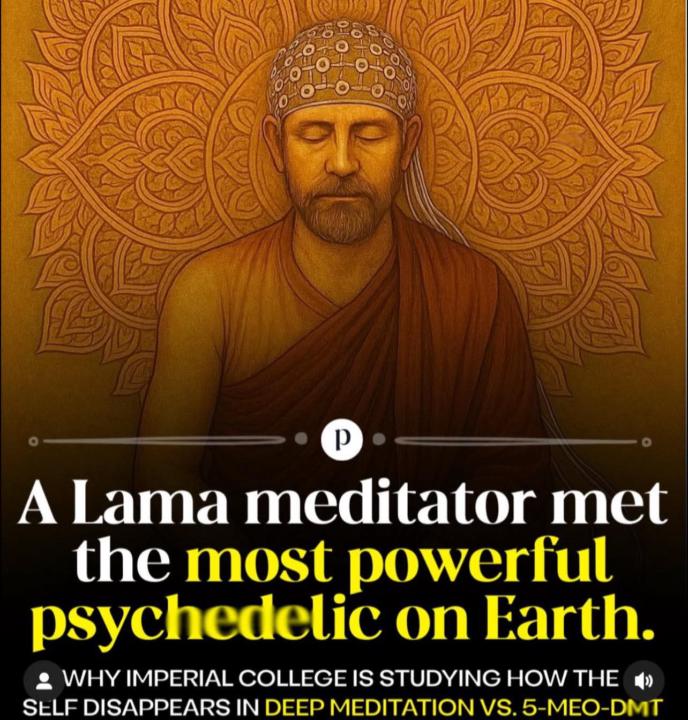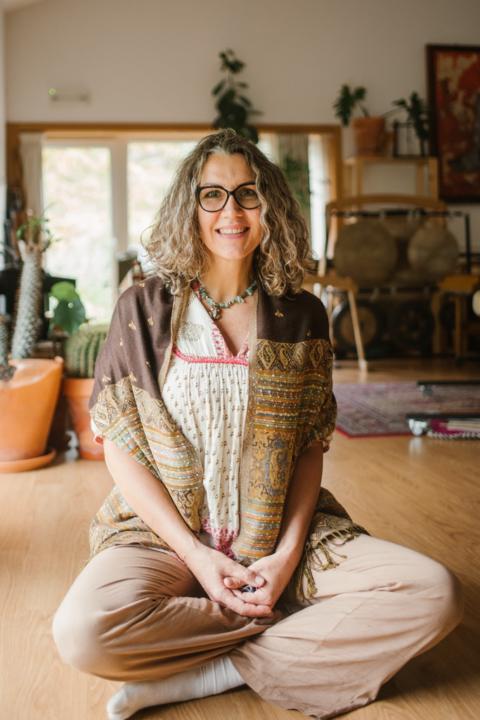Activity
Mon
Wed
Fri
Sun
Jan
Feb
Mar
Apr
May
Jun
Jul
Aug
Sep
Oct
Nov
Dec
What is this?
Less
More
Owned by Lisa
Join our free non-dual community to connect with a global family of seekers. Discover your inner guru and integrate spiritual wisdom into your life.
Memberships
Skoolers
180.8k members • Free
55 contributions to Shangriballa - Non Dual Group
Effortless Mindfulness and traumas
Effortless mindfulness frames trauma work as shifting the “place you are aware from.” Core points: 1. Do not drop into traumatic material from the thinking mind. First shift into open, spacious awareness. 2. From that wider awareness, let traumatic sensations or memories appear as objects in the field, not as your identity. 3. Maintain separation: awake awareness is stable, the trauma content moves inside it. 4. Let awareness “receive” the sensations without pushing for catharsis or narrative. 5. If intensity rises, widen awareness again until regulation returns. 6. Work in short cycles. No deep immersion. Integration happens by repeated brief contact from a safe vantage. It is a regulation approach, not a replacement for clinical treatment.
Happy Birthday?
Yesterday I received the most unexpected birthday present. While getting ready for sleep, I entered a state of trance and quickly experienced qualified primal fears (fear of death, fear of others, fear of scarcity....) At first awareness would be drawn to the fear and identified with it, "I" was afraid, scared, dread. Then the fear would become familiar, less intense, letting an observer emerge. Eventually the observer would take a step back, and fears would become mere elements on a scenery. Ultimately, awareness moved from identification with fear to a stable observation position. The mind enjoyed the rest of the trance freely moving from one state to the other. Today no milk, has my fear gone away?
Giving 5MEO to a Lama and advanced meditator
We've all heard the spiritual talk: "Meditation can dissolve the ego," or "True enlightenment is just a moment away." But how does that stack up against a chemical shortcut, like a powerful psychedelic? Imperial College London, led by Dr. Chris Timmermann, decided to find out. They put one of the world's most advanced Mahamudra meditators—a Lama with 17 years and over ten thousand hours of practice—into the lab. The question that drives this research? Can the sense of self switch off in more than one way? The Experiment: Nond Gual vs. 5-MeO-DMT This was a first-of-its-kind experiment. They directly compared the Lama's brain and self-awareness across three different conditions, all within one protocol: - Nond Gual Meditation: The Lama entered a deep meditative state where the boundary between "me" and the world softened. He reported clarity and equanimity. - Low Dose 5-MeO-DMT: A small dose of the psychedelic, which brought imagery, emotional shifts, and a quieter sense of self. - High Dose 5-MeO-DMT: A stronger dose that completely removed the body and the environment, leaving only a bright, empty awareness. The Lama described the awareness as subtle, with no notion of the "gross aspect of self". They tracked brain data, psychological ratings, and interviews moment-by-moment. 🧠 What the Brain Waves Told Us Brain rhythms are just electrical waves that shift with different states of mind. The recordings revealed some seriously intriguing differences: - Nond Gual Meditation & Low Dose 5-MeO: The brain became quieter and more stable. Alpha activity (linked to calm focus and a quiet mind) increased, and gamma activity (linked to active thinking and intense sensory processing) dropped. - High Dose 5-MeO: This was a different beast entirely. Gamma activity increased, and the signal became chaotic. The brain signal showed high Neural Entropy (a measure of chaotic brain signal), matching the flood of intense internal experience. - - The Big Takeaway: An AI trained on the Lama's nond Gual brain activity recognized the low dose of 5-MeO as similar—they shared an overlapping neural signature. But the AI did not recognize the high dose.

New in the Classroom: Step 4 Non-Dual Release Session!
Hey everyone! We've uploaded a compelling, insightful new video demonstration of the Shangriballa Method classroom—you definitely don't want to miss this one. We're excited to share Part 4: The Non-Dual Release Session done with Dagmar! This session is a crucial piece of the puzzle because it brings together everything we’ve talked about in the previous steps and shows you exactly how the theory translates into real-time somatic release. What You'll See in This Session This is a profound, yet gentle inquiry. Dagmar was focusing on an underlying charge related to her relationship with her father. Watch how Patrick expertly navigates this deep, relational material: - From Belief to Body: Patrick guides Dagmar from the mental awareness of a core belief right into the physical feeling—the somatic imprint—of that paternal dynamic. - Meeting the Wounded Child: You'll see the crucial moment where Dagmar connects the pain to the Wounded Child part of herself, shifting the dynamic from self-blame to self-compassion. - Witnessing the Release: The session brilliantly demonstrates how the loving awareness of who we truly are is the necessary container for the release. The journey concludes with a beautiful sense of gentleness and softness, proving that actual release doesn't require a struggle; it requires presence. 🙏 A Big Thank You! We want to send immense gratitude to Dagmar for her courage and generosity in sharing this deep, personal session with the entire Shangriballa community. Sharing this vulnerable process is a powerful gift to all of us who are learning. And, of course, a huge thank you to Patrick for his masterful, gentle guidance, demonstrating the Shangriballa Method in action. You can find the video uploaded now in the classroom section under the Shangriballa Method module! Dive in, watch closely, and let us know your biggest takeaway in the comments below!
The Unseen Architect: How Trauma Shapes Our Minds, Bodies, and the Path to True Self
Have you ever considered the profound connection between your deepest psychological experiences and the very cells of your body? It's a relationship far more intricate and impactful than many realise, especially when it comes to the lingering shadow of trauma. We often compartmentalise our physical and mental health, treating them as separate entities. But what if the suffering in our minds – particularly that stemming from unprocessed trauma – is not just related to physical and mental illness, but can directly manifest as it? This isn't just philosophy; it's a growing body of scientific understanding, powerfully illustrated by conditions like Dissociative Identity Disorder (DID), formerly known as Multiple Personality Disorder. Examining DID offers us a dramatic window into how our memories, identities, and especially trauma, can literally sculpt our physical reality. When the Mind Divides, the Body Follows: Lessons from Dissociative Identity Disorder Dissociative Identity Disorder (DID) is a complex condition born from severe, repetitive childhood trauma. In DID, a person develops distinct identity states, or "alters," each with their own memories, behaviours, and even ways of relating to the world. But here's where it gets truly astonishing: clinical evidence and research suggest that these distinct alters can experience the world, and even their own bodies, in fundamentally different ways. Imagine a person with DID where: - One alter suffers from severe allergies to a particular food, experiencing hives and difficulty breathing, while another alter, when "out," can consume that same food with no adverse reaction whatsoever. - An alter requires corrective lenses to see clearly, but when another alter is in control, their vision is excellent without glasses. - Chronic pain or even conditions like asthma or diabetes might be present and active for one alter, requiring medication, but subside or even disappear when a different alter fronts. - Responses to medication can vary dramatically; an alter unaware of a medication might not respond to it, while another who knows of it does.
0 likes • 11d
@Fathy Akrouf You're right, the personality, the ego, the actor on the stage is volatile. When one alter vacates, it proves that the persistent self isn't found in the content (memories, preferences, identity). Here’s the non-dual shift. 1- The Actor (Ego): This is the content. It changes, fractures, and leaves the stage, whether you have DID or change your mood during the day. 2 The Audience (Awareness): This is the persistent self we talk about. It is the awareness that perceives the shift from one personality or state to the next. The trauma fractured the actor, but it never touched the Audience. The healing journey isn't about making the actor stable; it's about realising that "I am the unchanging awareness watching the play. 💚
1-10 of 55
Active 1d ago
Joined May 19, 2025
Powered by


